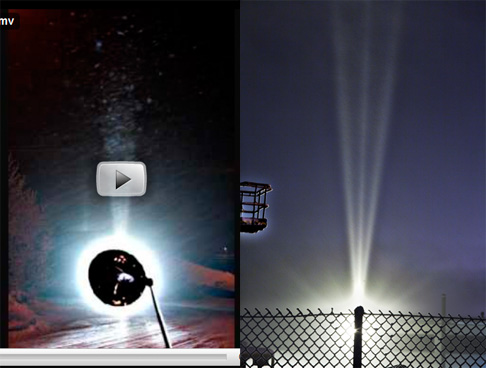Saturday, 16 January 2010
New halo in elliptical halo / Bottlinger family Part II
A video and two new images of the 09-10 January 2010 Display in Kangasala, Finland are now available for viewing (1 - 2 - 3). As you follow the first link please note that the video is displayed below the still image.
The video consists of 79 consecutive still images, each shot with a 6s exposure time. The camera shot a new frame automatically as the last one finished so the exposures lasted for 479 seconds (just under 8 minutes). Based on the EXIF data recorded by the camera the 79 frame sequence lasted for 585 seconds (so 106 seconds of the time were used by the camera's internal electronics and the operation of the shutter mechanism between frames). This time frame of 585 seconds is compressed into 20 seconds on the video.
The width of the halo changes abruptly between frames in the video. At one point (about three seconds into the video) the shift is particularly dramatic. Either the change is due to sudden changes in crystal orientations or the apex angle of the halo forming wedge in the crystals was changing (probably in steps, not in smooth continuity).
Part I of this post can be found here: (4)
Edit: new animated images are available (5 - 6). See comments for more information.
Labels:
Displays
Subscribe to:
Post Comments (Atom)

I guess even the smallest gust changes the crystal orientation enough to make difference. The long exposures don't give enough steps to show smooth, but rapid, changes.
ReplyDeleteYes the 6s exposure time does not allow for great sequential resolution but I would still characterize the change as sudden.
ReplyDeleteIn particular, the video shows the turbulent movement of the air mass. If we are talking about changes in orientation (and indeed inclined orientations as the cause of the halo) then we must accept that even in that turbulent air the orientations have been great to produce a sharp halo and also that the orientations were able to shift suddenly to produce another sharply defined halo.
Furthermore, the shift seems to take place suddenly and then hold instead of changing between each frame.
I just view the vid and that is so cool it did just like my elliptical halo did back in 2008.
ReplyDeleteI have just briefly read Walt's paper and glanced over the diagrams. This treatment seems a good fit (of course, as Walt says, it does not concern the origin of the sloped crystal faces).
ReplyDeleteIt is a pity that we did not observe this pillar with high (even 20 degs) lamp elevations: the floodlights always had to be relatively far away in order for the halo to be seen and we had no means to even place the spotlight at any decent elevation.
Walt, what do the simulations predict about the spotlight halo at 0 degs elevation?
Of course, there is the possibility that crystal populations with different sails flew past the lens. As a new population flew in front of the lens the new tilt would change the halo.
ReplyDeleteEither way (wedges vs tilts) the crystals were oriented as they formed the halo.
I just read Walt's excellent treatment on this halo. The 60, 62 etc degres helic arc nomenclature is actually pretty nice.
ReplyDeleteYeah, like Jari says, we did not observe this with high lamps. I would say the floodlights in the images where the Bottlinger is seen are 1-3 degs above the horizon.
Sure, we took at look near the lamp as well, but there was nothing to be seen, except for the upper pillar which curved as Walt's diagrams predict.
My regular gallery host does not support animated gifs. So I got the idea to embed mine here:
ReplyDeleteSo, these are two frames, one shot immediately after the other (as fast as the camera can, automatically) and each frame was exposed for 6 seconds.